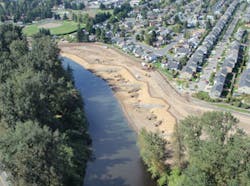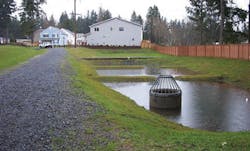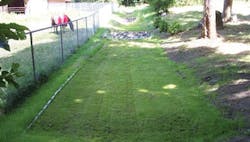By William Atkinson
As water, wastewater and stormwater utilities make plans to upgrade, repair or replace their existing crumbling infrastructure, more and more of them are looking to incorporate sustainability and other "green" strategies into their plans.
There are several opportunities for doing so, and one recent report, "Infrastructure Crisis, Sustainable Solutions: Rethinking Our Infrastructure Strategies," published by the Center for Sustainable Infrastructure at the Evergreen State College (Olympia, Wash.), delineated a few at the micro level.
"As with energy microgrids, neighborhood-scale water systems -- including rainwater harvest, wastewater micro-processors with water recycling, and the range of green stormwater facilities -- can nest advantageously within the larger system while saving money, enhancing resilience and conserving valuable capacity within the larger system," it said.
According to the report, sustainability and green opportunities exist at a more macro level as well. The findings indicated that "for all the water-based infrastructures, investing in open space and natural systems and building nature-mimicking green infrastructure facilities can, in many cases, deliver better results cheaper than relying too heavily on spending on pipes, pumps and traditional treatment."
In other words, all types of water infrastructure improvement should be looked at on a more holistic basis. "We are starting to see more of a trend toward a holistic view of water," said Chris Taylor, executive director for the West Coast Infrastructure Exchange (www.westcoastx.com). "Currently, most water, wastewater and stormwater entities and projects still tend to be organized and handled separately, which works against sustainability and is also more costly.
"To get innovations more widely accepted, we need a way to get smaller systems to regionalize and collaborate in some other way to achieve scale," he added.
Taylor cited an example: A number of communities have combined sewer overflow (CSO) systems, which co-mingle stormwater with sewage. "These communities have been paying a heavy price to try to undo this because it turns out that stormwater is much more treatable than sewage and can be a resource," he said.
Many communities, however, are ahead of the curve. Taylor noted that Los Angeles and other cities are now using stormwater as a way to recharge aquifers, providing a less expensive marginal source of water than desalination or large pipelines that bring water in from long distances.
Wastewater reuse is also being given due consideration. "Overall, in terms of wastewater treatment, the technology is available to move toward more sustainability," said Taylor. "In most cases, it's just a matter of regulatory issues and the challenge of getting people to accept it."
One example of a holistic approach to green water infrastructure can be found in the Eugene, Ore.-based Water & Electric Board's (EWEB) Voluntary Incentives Program. "The program is designed to protect the area's drinking water supply," said Joshua Proudfoot, principal with the sustainability consulting firm Good Company (www.goodcompany.com). "EWEB has mapped the threats and opportunities to improve the safety and purity of the water supply across publicly and privately held lands and then set priorities for ecosystem management of each action area."
EWEB's program offers technical support and financial incentives to manage the properties according to principles that promote ecological function, which, in turn, produces clean water. "EWEB works with all landowners, including industrial forests, agriculture, golf courses, resorts, private residences, and state lands on a prioritized basis and determines what needs to happen site by site," said Proudfoot.
This may include clean-up of toxins from farm chemicals, planting native buffers along streams, or supporting conversion to organic practices and connecting farmers with higher-value buyers to reduce pesticide runoff. The program rewards those who continue to maintain the ecological function that matters, not just those who convert but then slowly drift back to the previous condition.
"The program is also building bridges to other agencies and land developers to take their mitigation dollars and ensure that the ecological functions are not just replaced but are also part of a watershed-scale look at priorities," said Proudfoot. These priorities include drinking water purity for humans; fish passages; habitat for land-, water- and air-based creatures; and cooling of the water, which produces more flow and sediment reductions and carbon sequestration.
Another community taking steps toward holistic water infrastructure sustainability is the city of Portland, Ore. In fact, the city's visionary efforts stretch back for decades.
In 1999, Portland adopted a Stormwater Management Manual. "This was a huge step in addressing the impacts that development and redevelopment have on our wastewater and stormwater systems," said Linc Mann, public information officer for the City of Portland's environmental services bureau. "It requires that every effort be made to manage stormwater runoff from private properties before connecting to the public system."
This ensures that the cost of development includes the costs of managing any additional runoff that is created. The use of green infrastructure -- particularly infiltration -- for stormwater management has been given the highest priority in the stormwater management hierarchy.
Green infrastructure is also a key part of Portland's CSO and combined sewer capacity control strategy, according to Mann. The combined sewer system mixes sanitary sewage with stormwater runoff in the same pipes. Because of increases in pavement and other impervious surfaces over the years, the volume of stormwater flowing into the pipes is much greater than the system was designed to manage 100 years ago. Heavy rains could cause sewers to back up into basements and flood streets.
In the early 1990s, the city began taking steps to remove as much relatively clean stormwater as possible from the combined sewer system, including infiltration of stormwater runoff from residential streets into subsurface sumps and the creation of a Residential Downspout Disconnection Program. Over 56,000 downspouts from over 26,000 private properties in the combined sewer area were disconnected from the sewer and redirected onto lawns and into infiltration facilities. "It is estimated that this program saved over $200 million in CSO construction costs by reducing the size of the tunnels needed to store and convey combined sewage," said Mann.
Green infrastructure is also integral for restoring capacity to Portland's existing combined sewers. "Green infrastructure facilities slow down the runoff and also remove runoff volume through infiltration," said Mann. "This can allow pipes that may be small but in otherwise good condition to remain in place, saving substantial dollars over traditional projects to install larger sewer pipes."
One example is the "Tabor to the River Program," which involves the installation of over 500 "green streets," along with tree planting, private property retrofits and pipe replacement for the sewers in the worst condition. "Combining both gray and green infrastructure into the ‘Tabor to the River Program' has saved about $50 million when compared to a gray-only solution," said Mann.
Portland has been continuing its efforts. In 2005, the Portland Watershed Management Plan laid out a comprehensive, strategic and integrated approach to improved watershed health. Historically, there had been separate watershed plans for the city's five watersheds. "The 2005 plan seeks efficiencies and greater flexibility to find multi-objective solutions that meet multiple requirements and save money," said Mann. "The activities of multiple city bureaus are integrated, which maximizes limited resources."
King County in Seattle, Wash., is also on the cutting edge of integrating sustainability into its water infrastructure through holistic strategies. Mark Isaacson is director of the King County Water and Land Resources Division, the department responsible for the county's stormwater management. "However, we also manage the county's river system and levee systems and consider all of these to be part of our infrastructure because they are critical to our urban environment," he said.
On the stormwater side, the department has implemented low-impact development requirements for new projects in unincorporated parts of the county. "The goal is to disperse the amount of stormwater that goes into the groundwater," said Isaacson. "Rather than have it go directly into the creeks and other natural drainage systems, we try to disperse it onsite as much as possible." This reduces the burden on the public sector for maintaining a centralized system. "We can't entirely get away from centralized facilities, but we can reduce the demand," he said.
With regard to the levee system, the department spends a lot of time managing for flood control and studying how the rivers interact with the natural environment and the county's cities. "We are developing a number of corridor plans and have invested money into revamping our levees as well as widening the river channels so we have a more sustainable approach that reduces maintenance costs and accommodates increased flow, as might occur with climate change," said Isaacson.
For water, wastewater and stormwater utilities considering sustainability and other "green" initiatives during infrastructure upgrades, Taylor offered a suggestion: "When considering sustainable water infrastructure projects, it makes more sense to plan long-term and do everything only once, instead of planning multiple projects that require tearing up roads and infrastructure multiple times to make incremental improvements."
About the Author: William Atkinson is a correspondent for WaterWorld Magazine. He has been a full-time freelance business magazine writer since 1976, specializing in infrastructure, sustainability, supply chain, risk management, and safety/health.
More WaterWorld Current Issue Articles
More WaterWorld Archives Issue Articles





